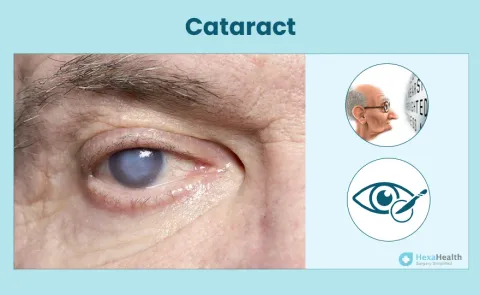Cataract treatment is a medical intervention aimed at addressing the clouding of the eye's natural lens, which is known as a cataract. It primarily involves surgical procedures that remove the clouded lens and replace it with an artificial intraocular lens (IOL), restoring clear vision

Cataract Treatment without Surgery
Cataracts are treated with surgery, but some non-surgical methods, like prescription eyeglasses, lifestyle changes, and medications, might help slow their progression or temporarily improve vision. However, these methods don't remove cataracts; surgery is usually necessary for a long-term solution.
Read in detail: Treatment of Cataract without surgery
Cataract Treatment with Surgery
-
Phacoemulsification (Phaco): This is the most common technique for cataract surgery. It involves creating a tiny incision in the eye and using ultrasound waves to break up the cataract, which is then removed through suction. An IOL is then implanted.
-
Extracapsular Cataract Extraction (ECCE): In this traditional technique, a larger incision is made to remove the cataract in one piece. An IOL is also inserted.
-
Laser Cataract Surgery: Laser cataract surgery also known as femtosecond laser-assisted cataract surgery is a cutting-edge and advanced technique which involves the use of a specialised laser to perform certain steps of the cataract removal process.

Cataract Treatment in Ayurveda
Ayurvedic treatment for immature cataracts focuses on preventing and managing the condition using natural remedies like Triphaladi ghana vati and Elaneer kuzhambu
It delays progression and improves eye health, with combined therapies often more effective.
Always consult a healthcare professional before starting any Ayurvedic treatment for cataract
Cataract Treatment in Homeopathy
Homeopathy provides cataract treatments that aim to slow progression and relieve symptoms, serving as a complementary option rather than a replacement for conventional medicine
Cineraria maritima (CM) is well-known for its use in cataract therapy worldwide but refrain from self-medicating and consult with a qualified homoeopath.
Additionally, scientific evidence supporting homoeopathy for cataracts remains limited
Cataracts Treatment Cost
The expense is generally determined by several factors including the lens type (monofocal, multifocal, toric lens), type of technique undertaken, expertise of the eye specialist, type and location of the healthcare facility, insurance coverage and much more
To know the exact cost of cataract treatment in India, one must consult an eye specialist. The table below provides an approximate expense
|
Phacoemulsification cost
|
₹ 20,000 to ₹ 60,000
|
| Extracapsular cataract extraction cost
|
₹ 50,000 to ₹ 70,000
|
| Femto-second laser surgery cost
|
₹ 80,000 to ₹ 1,30,000
|
During cataract treatment, the natural lens is replaced with an artificial lens (intraocular lens—IOL). This artificial lens is designed to mimic the function of the natural lens.
It is made of several materials, such as silicone, acrylic, and other polymers, and is available in different shapes and sizes to accommodate the needs of individual patients
Below table provides an approximate cost of the cataract lens available in India
|
Lens Type
|
Estimated Cost Range
|
| Monofocal Lens
|
₹ 20,000 to ₹ 40,000
|
| Multifocal Lens
|
₹ 45,000 to ₹ 70,000
|
| Toric Lens
|
₹ 50,000 to ₹ 1,10,000
|










































